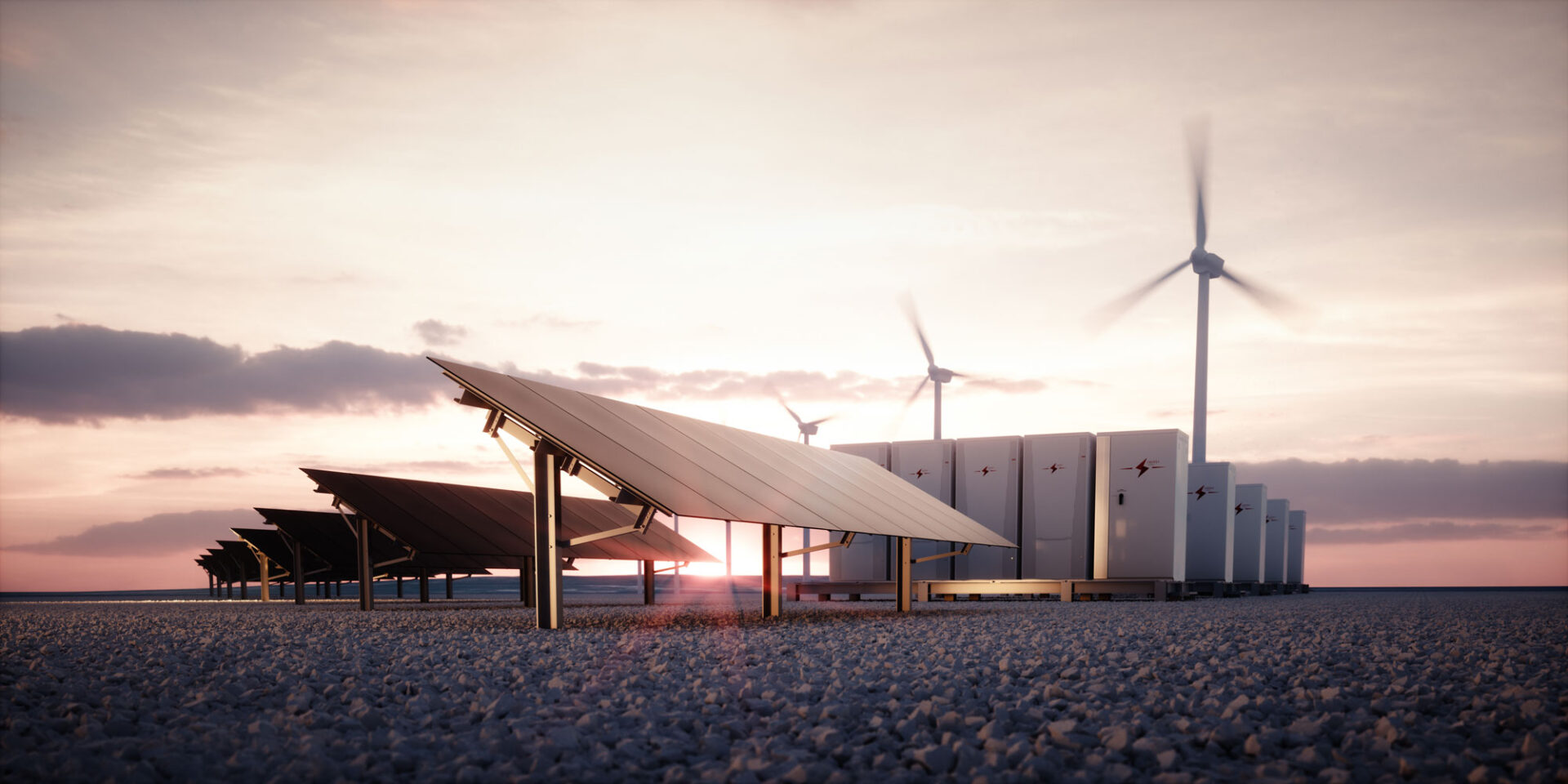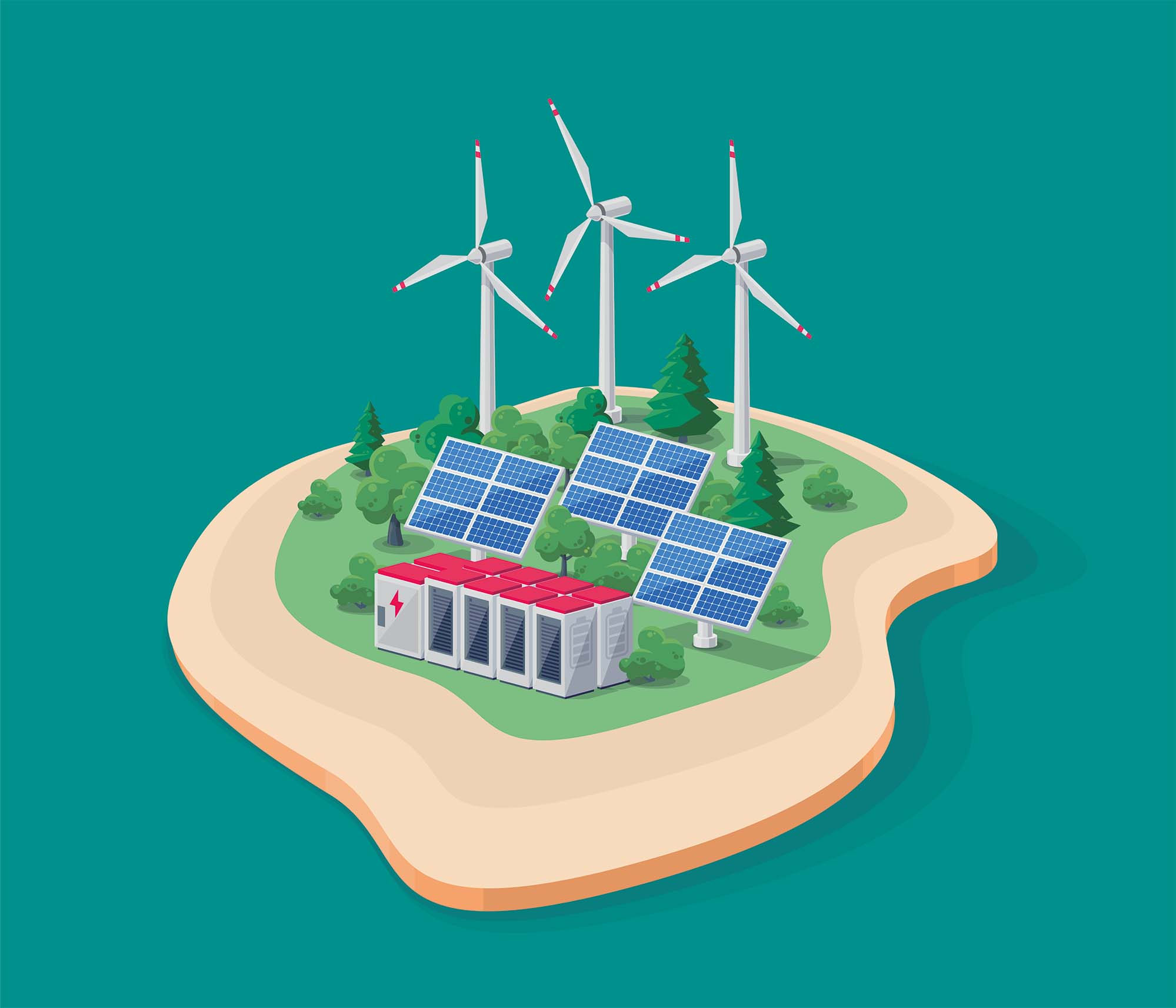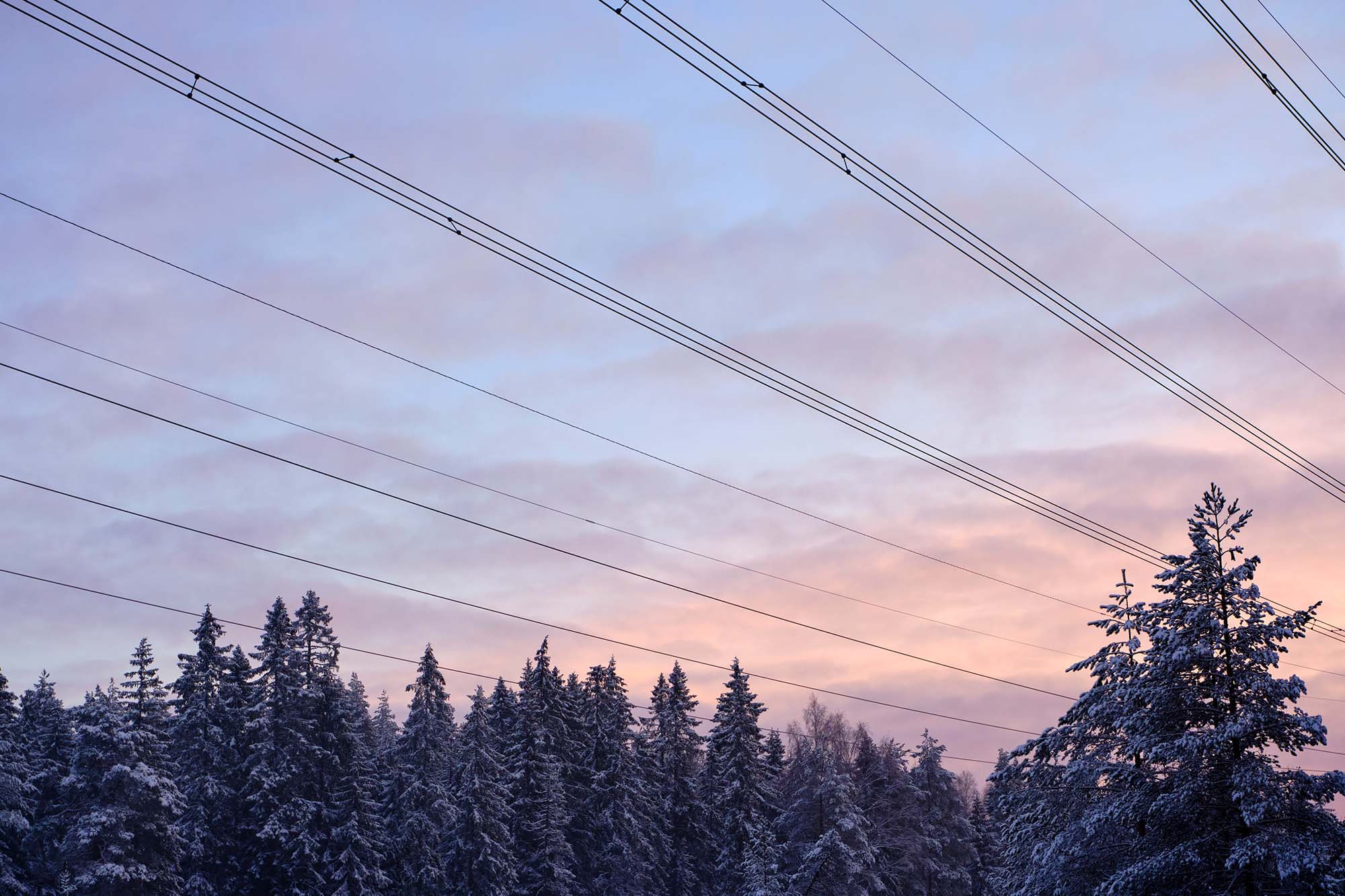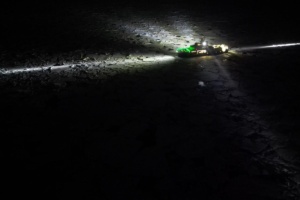We may be able to achieve as much as 30% of the necessary carbon emissions cuts solely through the electrification of transport, industry and large parts of society as a whole. However, it won’t be enough to just swap petrol tanks for batteries and fossil fuels for solar, wind and hydropower. We’re also dependent on the power grid, which connects new types of electrical consumption and new renewable energy. The power grid is an enabler of the green shift, and therefore it needs to keep up with electrification developments.
When we talk about electricity, we often use the words “energy and “power”. Simply put, “energy” is the amount of electricity that passes through a transmission line over a period of time, while “power” is the amount of electricity that passes through a transmission line at once. Think of it as water passing through a hose. The energy is equivalent to how many litres you use in total, and the power is equivalent to how many litres pass through the hose at any one time. If it takes 10 minutes to water your garden with 100 litres of water, the power is relatively low, as not a lot of water (energy) is passing through the hose at once. However, if it takes 1 minute to water your garden with 100 litres of water, you use the same energy but the power is 10 times higher.
More renewable energy from intermittent sources such as the sun and wind, increased power consumption, and higher demands for power have placed new requirements on the operation of and investments in the power grid. Higher power consumption and increased peak power (the time of day when the most electricity is used at once) have started to challenge the capacity of the power grid.
Traditionally, this has been solved by building more power transmission lines, but this is time consuming and expensive. Furthermore, as many of the country’s electrical grid operators have indicated, the current plans for developing the power grid are unable to be executed quickly enough to keep up with the demand.
We may be able to achieve as much as 30% of the necessary carbon emissions cuts solely through electrification!
There are many reasons for this, and therefore there are also many solutions. One of them is a new committee (the Nakstad committee, linked page in Norwegian), which was established with the intention of examining the regulatory barriers to faster grid development. At the same time, we must also research and quickly adopt new technology that will enable us to make better use of the power grid we already have (as well as the new one to be developed). This is where the flexible power grid enters the picture.
Flexibility is a blanket term that encompasses many effective solutions for utilising the capacity of the power grid in the best possible way. These solutions may be implemented by the grid operators in the way they monitor and operate the grid (known as explicit flexibility), or they may be implemented by the power customers, who actively adapt their electricity consumption based on grid capacity (known as implicit flexibility). However, a common feature of all these flexibility solutions is that they have the goal of utilising the existing grid to the greatest extent possible, so that we don’t have to develop as much new grid. This saves both society from the economic expense and nature from human interference.
It must be noted that even though finding smarter ways to utilise the grid sounds like a good idea (and as a rule it is), it isn’t always the most socioeconomic solution. Sometimes it’s actually more socioeconomically correct to expand the grid, and sometimes we must follow Winnie the Pooh’s example and say “Both”. Therefore, it’s important to investigate flexibility as an alternative strategy to traditional grid development in every situation in order to ensure that the best solution is chosen.
Later in this blog post, we’ll go through the different forms of flexibility, why flexibility is an effective solution to a number of the challenges faced by the power grid, and how flexibility is researched by SINTEF and NTNU through the research centre CINELDI.
What do we define as flexibility in the power grid?
Flexibility in the power grid can refer to many things, such as consumer flexibility, power producer flexibility, flexibility in the grid itself, and energy storage. However, before we dig any deeper into the various types of flexibility, we must first try to define flexibility in general.
At CINELDI, we operate with the following definition:
“Flexibility is the ability and will to modify production and/or consumer patterns at an individual or aggregated level, often as a reaction to an external signal, in order to be able to offer a service to the power system or maintain stable grid operations”.
Based on this definition, it would be fair to argue that the current solution isn’t particularly flexible, as it requires production and consumption to happen simultaneously. However, this isn’t necessarily the case in a flexible grid, which is capable of producing power when it is most beneficial and storing it in batteries, or another form of energy storage, until it is needed.
As power production becomes more flexible, power consumption will also become more flexible. As consumers, we want to have more control over our consumption so that we use electricity at times that are most favourable for the grid. And with the help of technology and control systems, we will be able to do this without impacting our daily routines.
Flexible power production
It would be wrong to say that Norwegian power production is currently inflexible. We’re fortunate enough to have a lot of hydropower, which leads to some production flexibility, as water can be stored in reservoirs (dams) and be used to produce electricity when it is needed. This is an important condition for maintaining the balance between production and consumption. Other countries depend largely on fossil fuel power stations to keep the balance between electrical production and consumption.
Even though hydropower has some untapped potential, we also need solar power and wind power if we are to meet the electricity needs in the years to come. The challenge is that, unlike drops of water, gusts of wind and sunshine cannot be stored until we need them. However, as we continue to develop solar and wind power, this is exactly what we need to do: store the energy. One way to do this is with batteries, which not only enable the production of solar and wind power to become flexible, as the energy can be stored until it is needed, but they can also be used together with hydropower to maintain the production-consumption balance.

While battery technology is not advanced enough for this task just yet, a lot of research on this topic is currently being conducted by both SINTEF and NTNU. For example, at CINELDI, we’re investigating how battery systems can be integrated into the power grid. We’re also looking at other exciting solutions such as how batteries in electric cars can be used to back up the grid.
Prosumers and distributed production
When electricity is produced closer to the power customers, or even by the power customers themselves, it is called distributed production. For example, electricity can be produced by buildings with solar panels on the roofs.
In addition to purchasing electricity from the market (in other words, where you and I currently get our electricity from), a power customer can also generate their own electricity. These types of customers are called prosumers. If a prosumer produces more electricity than they need, they can store it until it is needed using the battery technology we’re currently developing. Alternatively, they can send the electricity to the grid so that someone else can use it. Therefore, prosumers can be an extremely important source of flexibility in the future flexible power grid.

For example, if there is a lack of power in the grid, either because the producers are unable to meet the high demand or because the grid is overloaded, the prosumers may be notified of this and instead produce their own electricity or use the power they have previously stored in the batteries.
An even better scenario is that if the prosumer has a surplus of power, they can supply it to the grid and be paid for it! Alternatively, if there is a surplus of power in the grid (more power has been produced than is used), the prosumer can charge their batteries and be paid for the relief this provides the grid.
Some prosumers already exist today, but it’s expected that there will be many more of them in the future.
Consumer flexibility and equalisation of consumption
Traditionally, power customers have been extremely inflexible with our power consumption: we use electricity when it suits us and there aren’t any good incentives for us to adapt when and how we use electricity.
Sometimes it’s actually more socioeconomically correct to expand the grid, and sometimes we must follow Winnie the Pooh’s example and say “Both”.
However, after the installation of new electricity metres in 2019, it became easier for power customers to add flexibility to the power grid. For example, we can compare hourly measurements of our electricity use with the hourly price of electricity in the electrical power market. Some of us have already begun to use apps and equipment that can be connected to the HAN port on the metre in order to keep track of the price of electricity. Furthermore, many people charge their electric cars at times when the power is cheapest. We power customers are beginning to become more flexible.
This is the outline of a change we will continue to see in the coming years.
Even though consumption is increasing, the grid is not going to be constantly overloaded. The problem occurs at peak power, aka the time of day when the most power is used at once. During the times when few people are using power simultaneously, there is more than enough capacity.
Therefore, if we can distribute our consumption more evenly throughout the day, we will be able to postpone or avoid building new grids, as we will be making smarter use of the capacity of the existing grid. As the power customers are the ones who pay for the development of more grid in the form of increased network charges, the less grid we expand, the better it is for the power customer.
However many people ask themselves why they as a power customer have to adhere to the times of the day when there is good and bad capacity in the grid? And why should they care about adjusting their consumption accordingly? Will this not be an unnecessary strain on their everyday life? No, it doesn’t need to be.
For example, automatic control systems will be able to do a lot of the work for you. In addition, apparatuses such as boilers and underfloor heating cables don’t need to be turned on all the time, as they are able to store thermal energy in the water or the concrete floor. Therefore, they can be disconnected from the grid when there is poor capacity and reconnected later without causing the water or floor to become noticeably colder.
How electricity tariffs can make the power grid more flexible
Why should you as a power customer care about adapting your consumption in accordance with the needs of the power grid? Because you will be able to save money by doing so.
One way of levelling out the power consumption is through the use of electricity tariffs. Simply put, electricity tariffs are an alternative method of pricing the network charge, aka the cost of transference of electricity that you use, to the current one. When you use a lot of power (in other words, when you need a lot of electricity in a short period of time), it’s more expensive than if you distribute the same power consumption over a longer period of time. In addition, the price of transferring electricity can vary throughout the day. Moreover, it’s more expensive to use electricity when there is poor capacity in the grid (peak power) than when the grid has a lot of capacity.
You as a customer are thereby informed that the price is higher during the periods when capacity is challenged, and can adjust your consumption accordingly. Grid operators won’t earn more money from this solution (their income is strictly regulated and limited by the authorities. (Linked page in Norwegian)). On the contrary, the intention is to keep the costs down so that the grid rent doesn’t increase unnecessarily when we upgrade the power grid. If a customer actively takes advantage of tariff variations and the price of electricity, such as through automatic control systems, their power expenses can go down.
Microgrids and flexibility
Achieving a more distributed production and better opportunities to store power also allows for the possibility of microgrids. In practice, a microgrid is a small version of the national energy system. The microgrid can produce, use and store electricity, and can function completely independently or as part of the main grid.

One advantage of the microgrid is that it can be connected to the main grid when needed. This means that if there is an interruption in power that would impact an area covered by the microgrid, the microgrid can disconnect from the main grid and operate independently and completely unaffected by the power outage – at least until the normal supply has been restored.
Another advantage of the microgrid is that, just like consumer flexibility, it can contribute to postponing or avoiding expensive and time-demanding grid investments. Instead of building new cables from a power plant far away, more power can be produced locally, for example from solar panels, batteries can be installed to guarantee the production-operation balance, and a local microgrid can be established.
Flexible markets and system services
It is a known rule that there must always be a balance between consumption and production in the power system. The electrification of society and increased proportion of distributed production make it more difficult to maintain the balance. In addition, there is an increased likelihood of bottlenecks in the power grid, something that again could lead to problems with the voltage quality and overloading.
In order to ensure a stable and balanced power system that safeguards the security of supply, something called ancillary services are used. Examples of ancillary services include balancing services, voltage regulation and managing bottlenecks in the grid.
In a few years, both the system operator Statnett and the grid operators will use more flexible consumption in various grid services, so that the power maintains the required quality. This increases the need for coordination between Statnett and the grid operators in relation to both planning and operating the grid.
Flexible markets are important for the flexibility of the power grid
If we are to succeed with including the flexible resources in various ancillary services, we need agreements between those offering flexibility and the power customers. This can be done through separate market-based solutions, for example, via a marketplace for flexibility trading. NODES is one example of this type of marketplace. At CINELDI, we are running pilot projects for testing flexibility trading in NODES’ marketplace.
In a marketplace, those offering flexibility, such as a consumer who is able to reduce their consumption (perhaps as they have stored power from their solar panels in batteries) or an aggregator (someone who has access to flexible resources on behalf of multiple customers), can submit bids on the amount of flexibility they can contribute a given point in time and their desired price for this.
Similarly, the purchaser of flexibility, such as a grid operator who needs their consumption to be reduced, can submit offers on the amount of flexibility they wish to purchase at a given point in time and what they will pay the consumers for this. One reason that a grid operator may wish to reduce their consumption can be because they expect an overload of a transformer in the next 24 hours.
When an offer is chosen, the customer/aggregator will be notified of this, and reduce their consumption by an agreed volume and at an agreed price. This is an example of how customers can be an important resource for the power grid by making their consumption more flexible, or by interacting with the grid on the production and storage of electricity in the same way that prosumers do.








Comments
No comments yet. Be the first to comment!